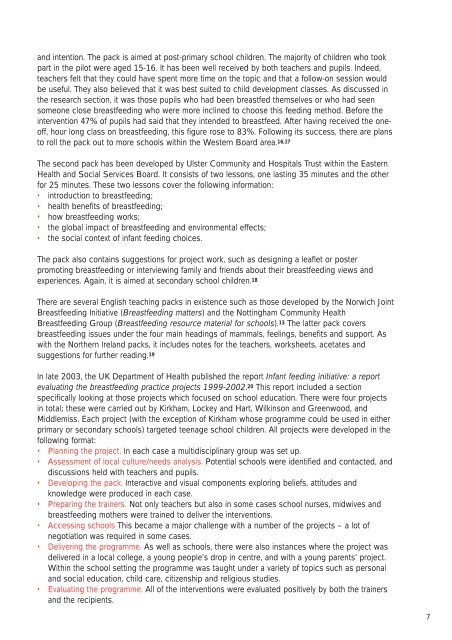Breastfeeding education in the school setting: - Health Promotion ...
Breastfeeding education in the school setting: - Health Promotion ...
Breastfeeding education in the school setting: - Health Promotion ...
Create successful ePaper yourself
Turn your PDF publications into a flip-book with our unique Google optimized e-Paper software.
and <strong>in</strong>tention. The pack is aimed at post-primary <strong>school</strong> children. The majority of children who took<br />
part <strong>in</strong> <strong>the</strong> pilot were aged 15-16. It has been well received by both teachers and pupils. Indeed,<br />
teachers felt that <strong>the</strong>y could have spent more time on <strong>the</strong> topic and that a follow-on session would<br />
be useful. They also believed that it was best suited to child development classes. As discussed <strong>in</strong><br />
<strong>the</strong> research section, it was those pupils who had been breastfed <strong>the</strong>mselves or who had seen<br />
someone close breastfeed<strong>in</strong>g who were more <strong>in</strong>cl<strong>in</strong>ed to choose this feed<strong>in</strong>g method. Before <strong>the</strong><br />
<strong>in</strong>tervention 47% of pupils had said that <strong>the</strong>y <strong>in</strong>tended to breastfeed. After hav<strong>in</strong>g received <strong>the</strong> oneoff,<br />
hour long class on breastfeed<strong>in</strong>g, this figure rose to 83%. Follow<strong>in</strong>g its success, <strong>the</strong>re are plans<br />
to roll <strong>the</strong> pack out to more <strong>school</strong>s with<strong>in</strong> <strong>the</strong> Western Board area. 16,17<br />
The second pack has been developed by Ulster Community and Hospitals Trust with<strong>in</strong> <strong>the</strong> Eastern<br />
<strong>Health</strong> and Social Services Board. It consists of two lessons, one last<strong>in</strong>g 35 m<strong>in</strong>utes and <strong>the</strong> o<strong>the</strong>r<br />
for 25 m<strong>in</strong>utes. These two lessons cover <strong>the</strong> follow<strong>in</strong>g <strong>in</strong>formation:<br />
• <strong>in</strong>troduction to breastfeed<strong>in</strong>g;<br />
• health benefits of breastfeed<strong>in</strong>g;<br />
• how breastfeed<strong>in</strong>g works;<br />
• <strong>the</strong> global impact of breastfeed<strong>in</strong>g and environmental effects;<br />
• <strong>the</strong> social context of <strong>in</strong>fant feed<strong>in</strong>g choices.<br />
The pack also conta<strong>in</strong>s suggestions for project work, such as design<strong>in</strong>g a leaflet or poster<br />
promot<strong>in</strong>g breastfeed<strong>in</strong>g or <strong>in</strong>terview<strong>in</strong>g family and friends about <strong>the</strong>ir breastfeed<strong>in</strong>g views and<br />
experiences. Aga<strong>in</strong>, it is aimed at secondary <strong>school</strong> children. 18<br />
There are several English teach<strong>in</strong>g packs <strong>in</strong> existence such as those developed by <strong>the</strong> Norwich Jo<strong>in</strong>t<br />
<strong>Breastfeed<strong>in</strong>g</strong> Initiative (<strong>Breastfeed<strong>in</strong>g</strong> matters) and <strong>the</strong> Nott<strong>in</strong>gham Community <strong>Health</strong><br />
<strong>Breastfeed<strong>in</strong>g</strong> Group (<strong>Breastfeed<strong>in</strong>g</strong> resource material for <strong>school</strong>s). 13 The latter pack covers<br />
breastfeed<strong>in</strong>g issues under <strong>the</strong> four ma<strong>in</strong> head<strong>in</strong>gs of mammals, feel<strong>in</strong>gs, benefits and support. As<br />
with <strong>the</strong> Nor<strong>the</strong>rn Ireland packs, it <strong>in</strong>cludes notes for <strong>the</strong> teachers, worksheets, acetates and<br />
suggestions for fur<strong>the</strong>r read<strong>in</strong>g. 19<br />
In late 2003, <strong>the</strong> UK Department of <strong>Health</strong> published <strong>the</strong> report Infant feed<strong>in</strong>g <strong>in</strong>itiative: a report<br />
evaluat<strong>in</strong>g <strong>the</strong> breastfeed<strong>in</strong>g practice projects 1999-2002. 20 This report <strong>in</strong>cluded a section<br />
specifically look<strong>in</strong>g at those projects which focused on <strong>school</strong> <strong>education</strong>. There were four projects<br />
<strong>in</strong> total; <strong>the</strong>se were carried out by Kirkham, Lockey and Hart, Wilk<strong>in</strong>son and Greenwood, and<br />
Middlemiss. Each project (with <strong>the</strong> exception of Kirkham whose programme could be used <strong>in</strong> ei<strong>the</strong>r<br />
primary or secondary <strong>school</strong>s) targeted teenage <strong>school</strong> children. All projects were developed <strong>in</strong> <strong>the</strong><br />
follow<strong>in</strong>g format:<br />
• Plann<strong>in</strong>g <strong>the</strong> project. In each case a multidiscipl<strong>in</strong>ary group was set up.<br />
• Assessment of local culture/needs analysis. Potential <strong>school</strong>s were identified and contacted, and<br />
discussions held with teachers and pupils.<br />
• Develop<strong>in</strong>g <strong>the</strong> pack. Interactive and visual components explor<strong>in</strong>g beliefs, attitudes and<br />
knowledge were produced <strong>in</strong> each case.<br />
• Prepar<strong>in</strong>g <strong>the</strong> tra<strong>in</strong>ers. Not only teachers but also <strong>in</strong> some cases <strong>school</strong> nurses, midwives and<br />
breastfeed<strong>in</strong>g mo<strong>the</strong>rs were tra<strong>in</strong>ed to deliver <strong>the</strong> <strong>in</strong>terventions.<br />
• Access<strong>in</strong>g <strong>school</strong>s This became a major challenge with a number of <strong>the</strong> projects – a lot of<br />
negotiation was required <strong>in</strong> some cases.<br />
• Deliver<strong>in</strong>g <strong>the</strong> programme. As well as <strong>school</strong>s, <strong>the</strong>re were also <strong>in</strong>stances where <strong>the</strong> project was<br />
delivered <strong>in</strong> a local college, a young people’s drop <strong>in</strong> centre, and with a young parents’ project.<br />
With<strong>in</strong> <strong>the</strong> <strong>school</strong> sett<strong>in</strong>g <strong>the</strong> programme was taught under a variety of topics such as personal<br />
and social <strong>education</strong>, child care, citizenship and religious studies.<br />
• Evaluat<strong>in</strong>g <strong>the</strong> programme. All of <strong>the</strong> <strong>in</strong>terventions were evaluated positively by both <strong>the</strong> tra<strong>in</strong>ers<br />
and <strong>the</strong> recipients.<br />
7

















